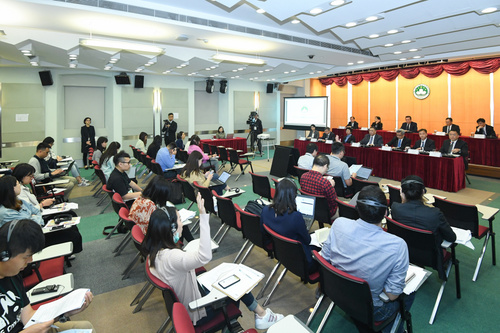 A press conference is convened at Government Headquarters by the Chief Executive, Mr Chui Sai On, and other members of the Commission for Reviewing and Monitoring the Improvements of the Response Mechanism to Major Disasters.
A press conference is convened at Government Headquarters by the Chief Executive, Mr Chui Sai On, and other members of the Commission for Reviewing and Monitoring the Improvements of the Response Mechanism to Major Disasters.
The Government is to deploy all-out effort to advance Macao’s overall capabilities for managing public emergencies, introducing measures ranging from optimisation of infrastructure and regulatory systems, to incremental expansion of resources and safety promotion and education.
The Chief Executive, Mr Chui Sai On, and other members of the Commission for Reviewing and Monitoring the Improvements of the Response Mechanism to Major Disasters, today gave a detailed report during a press conference on the progress of the Government’s efforts relating to disaster prevention and mitigation.
Mr Chui stated that the adopted short-, medium-, and long-term measures related to the existing conditions in Macao and drew reference from advices covered in the preliminary and final versions of the report assessing the overall impact of Typhoon Hato and which offered suggestions for optimising Macao’s mechanism for managing emergencies.
The works launched in relation to the management of public emergencies covered:
- Amendment to the executive order regarding tropical cyclone signals. It was expected that the amended version would be issued this month. The key changes include: updating the intensity scale to six from four; and updating measurements of average wind speed every 10 minutes – in line with guidelines from the World Meteorological Organization – instead of the current averages based on hourly readings. Amendment to the executive order on storm surge warnings, updating to a five-scale system from the existing three-scale system;
- Reinforcing stability of the electricity supply: the China Southern Power Grid would modify lines for power supply to Macao from overhead to underground. Such construction would be completed before the upcoming tropical cyclone season. The grid company would build one more 500kV-voltage substation, meaning the city would have three in total. Additionally, the grid company and the Companhia de Electricidade de Macau (CEM) would conduct an emergency simulation exercise later this month;
- Construction of a real-time monitoring system for the city’s pumping facilities; and relocation of existing main sewers in order to expand the city’s rainwater storage facilities;
- Launch by the Macao Economic Service of two subsidy schemes –respectively on 18 April and June – for local eligible businesses to install anti-flooding facilities;
- Amendment to regulations on public car parks, which would be issued before the end of this month. Public car parks in low-lying areas would be closed within an hour following issuance of a Signal No. 8 tropical cyclone or above, or the issuance of level-three storm surge warning;
- Trial run – during a civil protection drill, which to be held by month-end – of an integrated command system developed by Tsinghua University for the management of public emergencies;
- Incremental increase in the number of emergency shelters and resettlement sites: from the current four sites to 16, having a capacity for an aggregate of 23,000 people, and the selection of four sites, across the city, suitable during an emergency for mustering those members of the public that are in need, and then evacuating them to a safer place;
- The Education and Youth Affairs Bureau holding a session on 16 April to explain guidelines for schools during a public emergency.
Government officials also presented details of 10 major projects, to be initiated before year-end. They are: amendment to the Civil Protection Law; preparation of a city-wide proposal for management of public emergency; specific proposals for management of public emergency; a proposal for public departments in relation to management of public emergency; formulation of a 10-year plan for disaster prevention and mitigation (2019-2028); enhancing the stability of Macao’s electricity supply; relevant construction for emergency shelters and resettlement sites; public safety promotion and education; establishment of an insurance system covering losses from major disasters; and the construction of a cross-boundary system to control flooding in the Inner Harbour area.
The proposal for constructing a cross-boundary flood control system has gained support from the Guangdong government; and Macao and Guangdong have jointly made a proposal for approval by the Central Government.
The cross-boundary proposal included the construction of a flood barrier, 650 metres in width, in Wan Chai channel close to the estuary of the A Ma river. The proposed barrier has six movable gates and would be able to withstand tidal surges of up to 5.8 metres in height.
In addition, the Government proposed developing an internal barrier alongside the Inner Harbour, in order to strengthen flood control in the near term. The suggested 2.13-kilometre-long flood barrier would stretch from the Maritime Training School in Barra, to the New Maritime Administration Building in Doca do Lam Mau.
The internal barrier would be 3 metres high and be able to withstand tidal surges of up to 4.8 metres high. Tidal surges of 4.8 metres high were considered a rare event in Macao, only occurring on average once every 20 years.
The cross-boundary system would be one of the measures to complement the Government’s short-, medium-, and long-term measures to manage the flooding issues, Mr Chui stressed.
Mr Chui called for support and patience from members of the public, as construction of all flood control projects might somehow create inconvenience to the community.
He pledged the Government would spare no effort to take any steps – including law optimisation, increased resource input and speeding up or streamline administrative procedures – in order to maintain the safety of the public and their property.
Officials attending today’s press conference were: the Secretary for Administration and Justice, Ms Chan Hoi Fan; the Secretary for Security, Mr Wong Sio Chak; the Secretary for Transport and Public Works, Mr Raimundo Arrais do Rosário; the Commissioner-General of the Unitary Police Service, Mr Ma Io Kun; the Chief-of-Office of the Chief Executive’s Office, Ms O Lam; the President of the Administrative Council of the Civic Municipal Affairs Bureau, Mr José Maria da Fonseca Tavares; the Director of the Marine and Water Bureau, Ms Wong Soi Man; the Director of the Land, Public Works and Transport Bureau, Mr Li Canfeng; the Director of the Office for the Development of the Energy Sector, Mr Hoi Chi Leong; the Director of the Meteorological and Geophysical Bureau, Mr Tam Wai Man; and the Government Spokesperson, Mr Chan Chi Ping.


